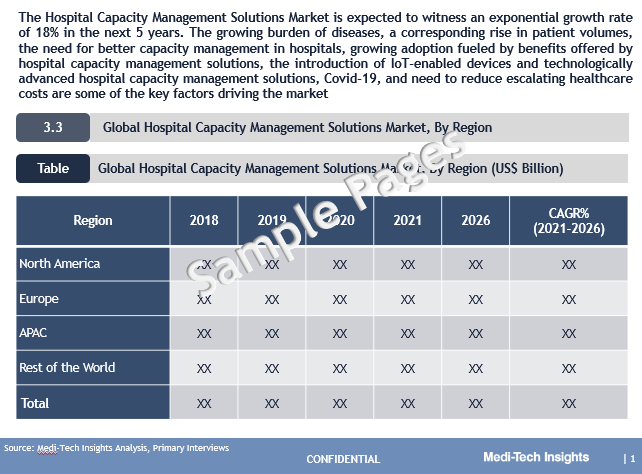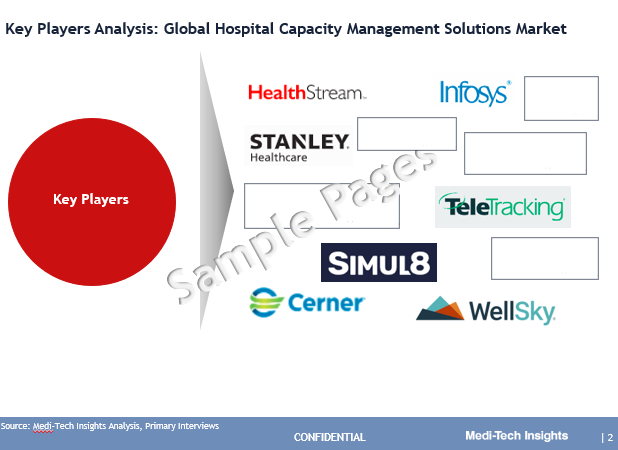
Hospital Capacity Management Solutions Market Size, Growth & Trends 2026

The Global Hospital Capacity Management Solutions Market is set to witness an healthy growth rate of 18% in the next 5 years. Growing burden of diseases, a corresponding rise in patient volumes, the need for better capacity management in hospitals, adoption fueled by benefits offered by hospital capacity management solutions, the introduction of IoT-enabled devices and technologically advanced solutions, Covid-19, and need to reduce growing healthcare costs are some of the key factors driving the market’s growth. However, concerns related to data security and privacy is likely to impact the growth of the global market.
Over the years, there has been an exponential rise in the number of patients and number of diseases globally, which has placed a huge burden on the healthcare sector. To offer better care, curtail escalating healthcare costs and deliver an incomparable patient experience, several hospitals are either deploying hospital capacity management solutions or seeking services of hospital capacity management service providers.
Hospital capacity management includes software and services offered by players that empower hospital executives, administrators and clinical staff with real-time hospital capacity planning and asset tracking.
Covid-19 Triggers Increase in Demand for Hospital Capacity Management Solutions Market
The Covid-19 pandemic adversely impacted health services globally and demanded large and rapid changes for patient care. Taking care of Covid-19 patients alongside patients with other conditions was a complex capacity planning challenge. The global medical community faced an unparalleled strain on its facilities and its resources in the wake of overcrowded hospitals, lack of oxygen cylinders, dearth of hospital beds, difficulty maintaining adequate staffing and supporting staff, extended waits for test results, shortages of critical supplies, materials, and logistic support and an expanding black market for drugs. The situation lead to increase in costs for hospitals, decreased revenues and posed as a threat to their financial viability. To address these concerns, hospitals embraced hospital capacity management solutions that helped hospitals to better monitor patient services and make optimum utilization of its resources to generate more revenue.
IoT-based Healthcare Capacity Management Solutions Opens New Growth Opportunities
For making decisions concerning long-term planning, facility performance and patient care & satisfaction, hospitals are increasing becoming reliant on data related to equipment assets, bed availability, workflows, patient/staff interactions, and safety compliance. Emergence of various IoT-enabled devices and real-time location systems (RTLS) has automated data collection on medical equipment location, usage and staff and patient interactions within all healthcare environments. This has helped facilities enhance compliance reporting, staff safety and shortage, workflow, hand hygiene and patient throughput by gathering meaningful data. Integrating RTLS data with electronic health records and computerized maintenance management systems generates comprehensive information around asset utilization and clinical workflow across the healthcare enterprise which in turn drives improvements for healthcare facilities and patients. There are several occupancy sensors also available in the market that monitor waiting areas and alert staff when approaching capacity so that critical patients can be diverted to other hospitals.
Introduction of IoT platforms that integrate smart sensors over a cloud-based network has also enabled hospitals to monitor cold storage and other aspects of their operations that must be maintained at specific conditions for safe patient care.
Hospital Capacity Management Solutions Benefits Fuels It’s Market Demand
Due to advancements in technology and interoperability, hospital capacity management software offers several benefits which is driving its adoption.
- The software automates patient room and staff assignments, which in turn reduces waiting time and crowding in the hospital
- The software increases bed turnover capabilities by communicating bed status automatically, allowing another patient to be treated quickly
- It decreases waiting times and time spent in the hospital which in turn lowers the risk of patient developing hospital acquired infection
- It helps in appropriate resource allotment by integrating real-time patient flows with business analytics
- It enables speedy communication between hospital staff, patients and caretakers
- Provides real-time visibility of patient location and status
- User-friendly dashboards ensure better time management and error reduction
“Hospital capacity management solutions follows a proactive approach for accurate demand forecasting. Bed management solutions, asset management solutions and patient care solutions allow hospitals to monitor patient services, makes optimum utilization of its resources and promotes better hospital risk management.” - Director, Leading Hospital Capacity Management Software Provider, United States
Organic and Inorganic Growth Strategies Adopted by Players to Establish Their Foothold in Hospital Capacity Management Solutions Market
The hospital capacity management solutions market is marked by the presence of both established and new players. Players operating in the market adopt both organic and inorganic growth strategies such as new product launches, and partnerships to garner market share. For instance,
- In October 2021, GE Healthcare partnered with Apprise Health Insights to launch nation's first automated statewide hospital bed management solution in Oregon. Oregon is the first state in the U.S. to launch a new statewide command center software solution for hospital capacity and critical resource management developed by GE Healthcare.
- In April 2020, TeleTracking Technologies, Inc., introduced a new enterprise COVID-19 capacity and census dashboard to equip health systems with the critical information needed to prepare for and respond to the COVID-19 patient surge. The dashboard provides real-time information related to patient census, bed availability, confirmed and possible COVID-19 patients, patients in need of ventilation, capacity of specialized treatment areas such as negative pressure and ICU rooms and patients by age.
The global hospital capacity management solutions market is a booming market that is expected to gain further momentum in the coming years due to growing prominence of digitalization, automation tools and data-driven solutions that utilize predictive analytics, AI, and ML. These tools are increasing being used for:
- Streamlining resource allocation in medical facilities.
- Doctors and care managers can outline populations, target their most complex patients, and identify rising-risk patients.
- Managing patient load and assisting in capacity management - Allocating emergency rooms based on the severity of the illness, and reducing patient service turnaround time.
- Streamlining insurance claim process that costs the hospitals significant labor hours. The technology also assists in checking eligibility and subsequent data migration, quickly and effectively.
Competitive Landscape Analysis: Hospital Capacity Management Solutions Market
The hospital capacity management solutions market is marked by the presence of players such as Cerner, McKesson, HealthStream, Stanley Healthcare, Infosys, Teletracking Technologies, WellSky, Simul8 Corporation, among others.
Key Strategic Questions Addressed
- What is the market size & forecast of the Hospital Capacity Management Solutions Market?
- What are historical, present, and forecasted market shares and growth rates of various segments and sub-segments of the Hospital Capacity Management Solutions Market?
- What are the key trends defining the market?
- What are the major factors impacting the growth of the Hospital Capacity Management Solutions market?
- What are the opportunities prevailing in the market?
- Which region has the highest share in the global market? Which region is expected to witness the highest growth rate in the next 5 years?
- Who are the major players operating in the Hospital Capacity Management Solutions market?
- What are the key strategies adopted by players?
The study has been compiled based on the extensive primary and secondary research.
Secondary Research (Indicative List)

Primary Research
To validate research findings (market size & forecasts, market segmentation, market dynamics, competitive landscape, key industry trends, etc.), extensive primary interviews were conducted with both supply and demand side stakeholders.
Supply Side Stakeholders:
- Senior Management Level: CEOs, Presidents, Vice-Presidents, Directors, Chief Technology Officers, Chief Commercial Officers
- Mid-Management Level: Product Managers, Sales Managers, Brand Managers, R&D Managers, Business Development Managers, Consultants
Demand Side Stakeholders:
- Stakeholders in Hospitals, Hospitals, Ambulatory Surgical Centers and Other End-users.
Breakdown of Primary Interviews

Market Size Estimation
Both ‘Top-Down and Bottom-Up Approaches’ were used to derive market size estimates and forecasts
Data Triangulation
Research findings derived through secondary sources & internal analysis was validated with Primary Interviews, Internal Knowledge Repository and Company’s Sales Data



